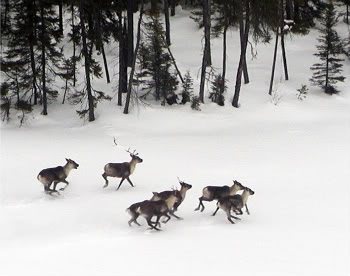Resource extraction, climate change, and deforestation cause declines in reindeer herds
|
|
Reindeer are beloved in the holiday season for the mystical role they play in guiding Santa from the North Pole to the world’s chimneys. However, according to a new book, reindeer, more commonly referred to as caribou, face increasing pressures from a variety of sources.
The new book entitled, Caribou and the North: A Shared Future, draws an intimate portrait of the only deer species where both male and females sport horns, while outlining the dangers which may lead these unique animal to become globally endangered.
“The caribou is central to the normal function of northern ecosystems,” said Dr. Justina Ray, Executive Director of WCS-Canada and a co-author of the book. “With their huge range requirements and need for intact landscapes, these animals are serving as the litmus test for whether we will succeed in taking care of their needs in an area that is under intensifying pressure.”
 Reindeer, more properly known as caribou. Photo courtesy of WCS. |
Caribou are the most numerous large terrestrial mammal in northern ecosystems, having adapted to a number of frigid habits, including tundra, boreal forests, and the polar north. Vital to these ecosystems, caribou serve as important prey for polar and grizzly bears, wolves, wolverines, foxes, ravens, hawks, and even the arctic’s only shark species, the Greenland shark. The caribou are also an important resource for Inuit peoples.
Despite the species wide-range of habitats and massive herds, the Caribou is under increasing threat according to the book’s authors. Climate change, deforestation, oil and gas extraction, including road building to service the industries, pose major obstacle to the caribou’s future. Already, caribou have been driven out of the continental United States where it used to dwell in all the border states with Canada. Looking with a wider lens, in North America caribou have lost one third of their Southern habitat. Herds in the Canadian provinces of Alberta and southern British Columbia are currently in decline. While even the massive herds of Northern Canada and Alaska are experiencing widespread population drops, which in turn affect all of the predators that depend on them from wolves to humans.
“We’ve learned a hard lesson in many parts of caribou range. When industrial developments like logging, mining and hydro-electric facilities and their accompanying road networks move in, the health of the ecosystem weakens, and caribou disappear. Our research on boreal forest caribou, which only thrive in intact ecosystems, tells us that we need to impose limits on the extent of industrial development to enable them to survive,” Dr. Ray said.
Already, a number of jurisdictions in Canada have classified caribou as ‘threatened’ or ‘endangered’. The Wildlife Conservation Society (WCS) used the caribou as one of its focal species in order to expand Nahanni National Park Reserve, a park in the Northwest Territories only accessible by helicopter or floatplane.
“Many children who grow up in North America and Europe are familiar with caribou as symbols of holiday myths and legends,” Ray explained. “It’s important to remember that reindeer play an important role in the rich ecosystems of the Northern Hemisphere that we all rely on. Protecting calving areas and other habitats needed to satisfy their enormous needs can help us conserve the caribou for the benefit of both the natural world and human culture.”
Related articles
Global warming harming plant-eating animals in the Arctic May 21, 2008
Climate change is making it more difficult for plant-eating animals in highly seasonal environments like as the Arctic to locate food, according to a new study published in the online edition of the journal Proceedings of the Royal Society B.
Satellite could help reindeer in the Arctic March 18, 2008
Researchers have used satellite data to detect Arctic conditions that cause mass starvation of hoofed animals depended on by native peoples. Some 20,000 musk oxen died on Canada’s far-northern Banks Island because of such conditions during the winter several years ago. Yet, their deaths went unnoticed until the next spring. The new satellite-detection method could provide an early warning to native people, giving them a realistic chance of getting food to herds to prevent mass starvation.
Canada’s Yellowstone Too Small for Wildlife
July 5, 2006
A new scientific report by the Wildlife Conservation Society, a 110-year-old science-based conservation organization, says that Northwest Territories’ Nahanni National Park Reserve — one of Canada’s most beloved and storied national parks — is too small to maintain its nearly pristine population of grizzly bears, caribou and Dall’s sheep.